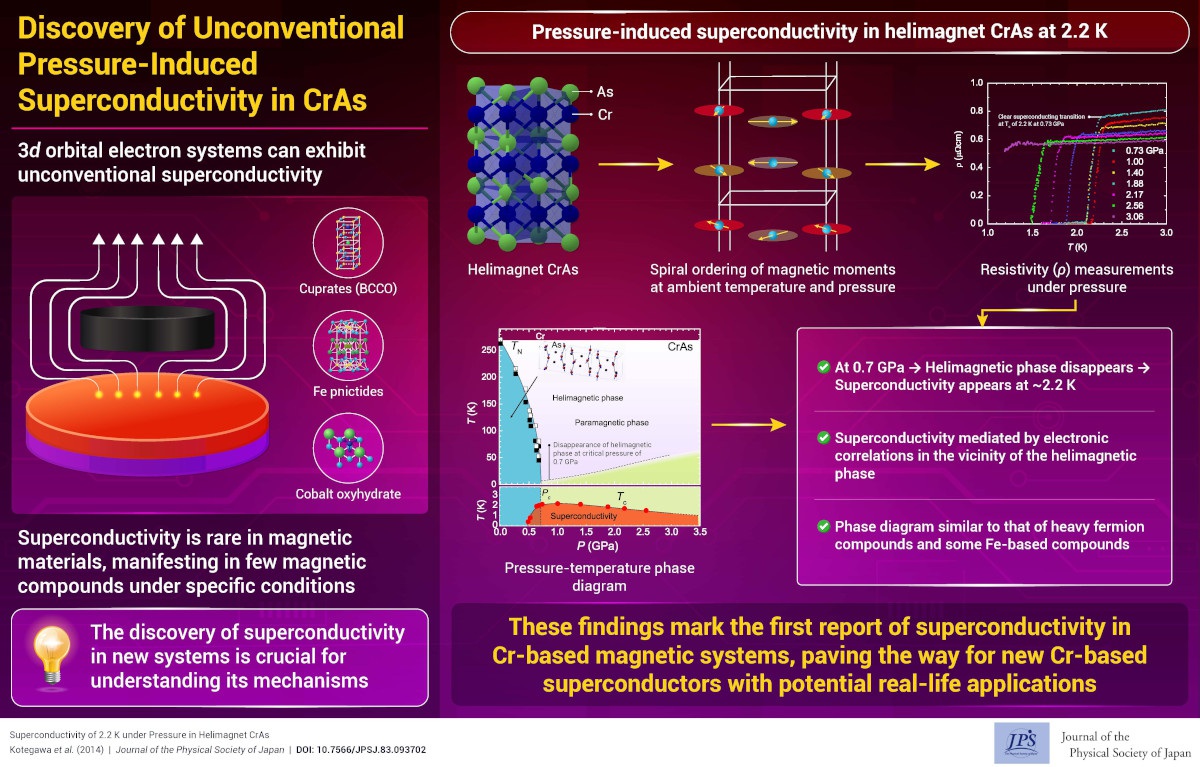Discovery of Unconventional Pressure-Induced Superconductivity in CrAs
© The Physical Society of Japan
This article is on
Superconductivity of 2.2 K under Pressure in Helimagnet CrAs
(The 29th Outstanding Paper Award of the Physical Society of Japan)
J. Phys. Soc. Jpn. 83, 093702 (2014).
A new study has discovered pressure-induced superconductivity in the helimagnet CrAs, originating in the vicinity of the helimagnetic ordering, representing the first example of superconductivity in Cr-based magnetic systems.

Superconductivity, the ability of certain materials to conduct electricity with zero resistance when cooled below a certain critical temperature, has intrigued researchers for over a century.
Superconducting mechanisms and symmetries vary depending on different materials; hence, discovering superconductivity in new systems is crucial for advancing research. For instance, some materials with transition metals with 3d electron systems can exhibit unconventional superconductivity, such as cuprates, iron (Fe) pnictides, and cobalt oxyhydrate.
Traditionally, superconductivity and magnetism were seen as mutually exclusive, making the discovery of superconductivity in magnetic materials particularly intriguing for new electronic states and applications.
In this study, we have discovered the existence of pressure-induced superconductivity in the helimagnet chromium arsenide (CrAs). In this material, at ambient pressures and low temperatures, there exists a helimagnetic order characterized by a spiral periodic arrangement of magnetic moments along a particular axis.
We conducted resistivity measurements on CrAs under a range of pressures. The results showed that the helimagnetic order is completely suppressed above a critical pressure of 0.7 GPa. Interestingly, at this pressure, when the temperature is lowered to about 2.2 K, superconductivity appears and persists for a wide range of pressures extending beyond 3 GPa.
Our measurements also show that the upper critical field, the magnetic field required to suppress conductivity, and coefficient A, which represents the inelastic scattering of electrons in the Fermi-liquid model of resistivity followed by CrAs, increase toward the critical pressure. This pressure dependence suggests that superconductivity in CrAs is mediated by electronic correlations.
Furthermore, based on these results, we constructed the pressure-temperature phase diagram of CrAs, which is similar to those of heavy fermion superconductors and some Fe-based superconductors.
This is the first example of superconductivity observed in Cr-based magnetic materials. Our findings shed light on the interplay of superconductivity and magnetism, offering crucial insights into mechanisms of unconventional superconductivity. The new physical properties of CrAs discovered in this study can inspire further research into helimagnetic compounds and other related materials, paving the way for the discovery of novel superconductors.
Considering the significance of these findings in the research of quantum-critical phenomena, this study has been recognized with the Outstanding Paper Award from the Physical Society of Japan.
In conclusion, our study shows that superconductivity can occur even in magnetic Cr-based materials, potentially leading to future discoveries of other Cr-based superconductors with real-life applications.
Superconductivity of 2.2 K under Pressure in Helimagnet CrAs
(The 29th Outstanding Paper Award of the Physical Society of Japan)
J. Phys. Soc. Jpn. 83, 093702 (2014).
Share this topic
Fields
Related Articles
-
Discovery of Light-Induced Mirror Symmetry Breaking
Dielectric, optical, and other properties in condensed matter
Electronic transport in condensed matter
2024-9-2
The authors discovered the light-induced mirror symmetry breaking, paving the way for controlling mirror symmetries via light and for realizing various phenomena utilizing the mirror symmetry breaking.
-
The Mysterious Superconductivity of Sr2RuO4
Superconductivity
2024-8-22
Researchers review the recent advancements made towards solving the mysteries of the unconventional superconductivity of Sr2RuO4, analyzing recent experiments and theoretical models and proposing approaches to resolve current challenges.
-
Antiferromagnetism Induces Dissipationless Transverse Conductivity
Electronic transport in condensed matter
Magnetic properties in condensed matter
Electronic structure and electrical properties of surfaces and nanostructures
2024-7-24
An investigation using high-quality NbMnP crystals demonstrates that the anomalous Hall conductivity arising from antiferromagnetism is dissipationless, as expected from the intrinsic mechanism.
-
Microscopic Exploration of Electronic States in Nickelate Superconductors
Magnetic properties in condensed matter
Superconductivity
2024-5-31
The multilayered nickelates, La3Ni2O7 and La4Ni3O10 , were investigated using nuclear magnetic resonance (NMR) at ambient pressure. Metallic electronic states under the density wave order were observed microscopically for both compounds.
-
Single-Crystal Growth of a Cuprate Superconductor with the Highest Critical Temperature
Superconductivity
2024-5-20
Millimeter-sized single crystals of a trilayer cuprate superconductor (Hg,Re)Ba2Ca2Cu3O8+δ that exhibits the highest superconducting transition temperature under ambient pressure, were grown reproducibly and safely.
